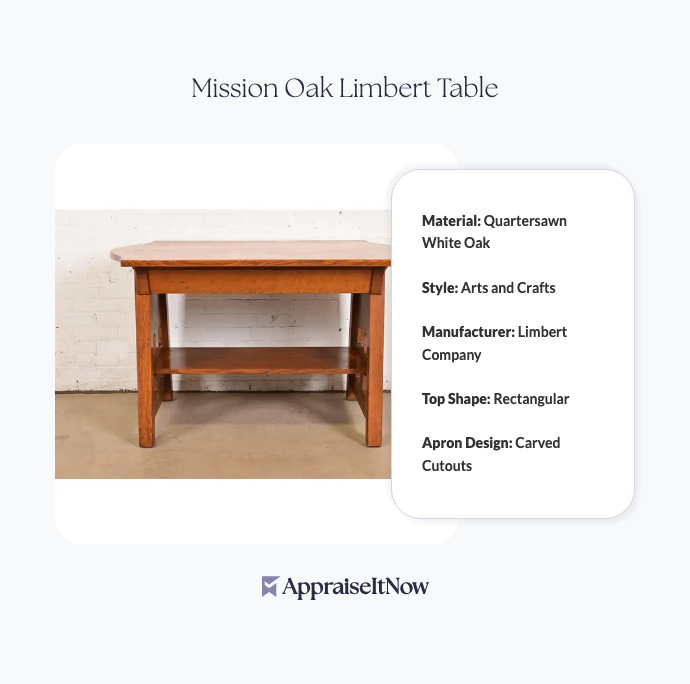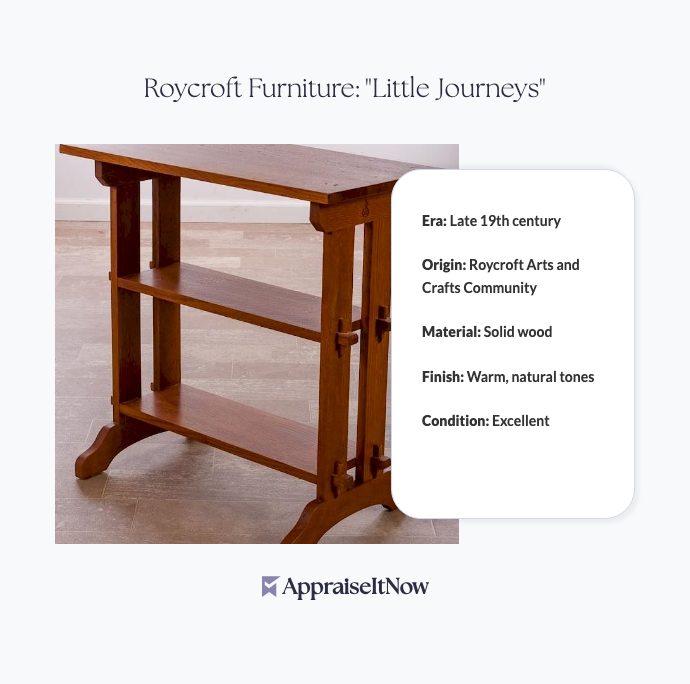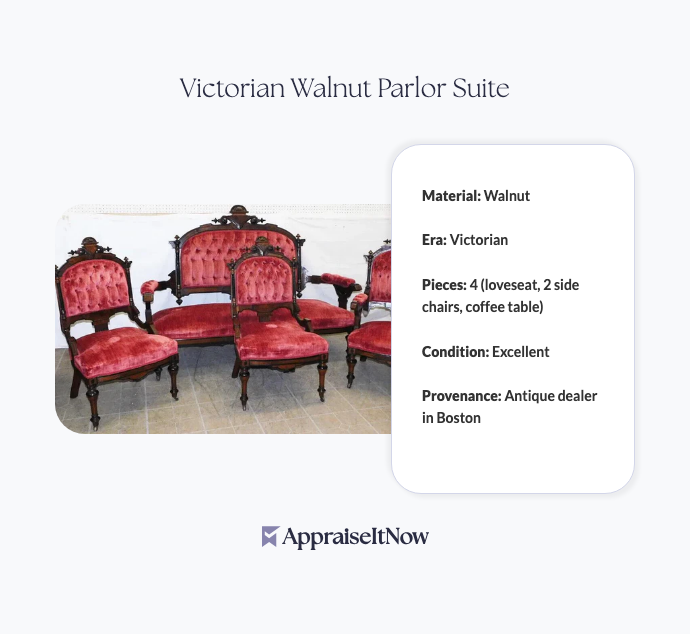<h1>How to Get Your L.J.G. Stickley Morris Chair Appraised</h1>
<p>The L.J.G. Stickley Morris Chair stands as one of the most prized pieces in the American Arts and Crafts movement, commanding <strong>$5,000 to $8,000</strong> in today's collectible furniture market. Whether you're inheriting a family heirloom, planning to sell, or simply verifying what you own, understanding how to properly appraise this iconic furniture piece ensures you get accurate valuation and proper documentation.</p>
<h2>Understanding the L.J.G. Stickley Morris Chair's Market Value</h2>
<p>Your Morris Chair represents more than just seating—it's a piece of American design history. Originally introduced in <strong>1903</strong>, the L.J.G. Stickley interpretation of the Morris chair became instantly recognizable for its distinctive sloped armrests, solid oak construction, and meticulous craftsmanship. The Arts and Crafts style that defines this piece remains highly collectible, with values remaining stable or appreciating over time depending on condition and provenance.</p>
<p>The question "<em>Does Stickley furniture hold its value?</em>" has a clear answer: yes. Quality Stickley pieces consistently demonstrate strong retention, making your Morris Chair a reliable <a href="/types/antique-furniture">antique furniture</a> investment. Unlike mass-produced modern furniture that depreciates rapidly, authentic Stickley pieces benefit from limited production quantities and recognized maker status, which directly supports market demand and resale potential.</p>
<div class="callout tip"><p><strong>Valuation Insight</strong></p>
<p>Authenticated pieces with clear maker's marks and original construction details command premium prices—sometimes 15-25% above pieces with questionable attribution or modifications.</p></div>
<h2>What Makes a Stickley Morris Chair Valuable</h2>
<h3>Key Identifying Features</h3>
<p>When assessing whether you have an authentic L.J.G. Stickley Morris Chair, certain features directly impact appraisal value. The mortise and tenon joinery techniques used by Stickley craftsmen represent superior construction compared to simpler fastening methods employed by competitors. This joinery method creates structural integrity that allows pieces to survive over a century of use while maintaining functionality and aesthetic appeal.</p>
<p>Your chair's solid oak construction distinguishes it from lesser versions made with veneers or mixed woods. During appraisal, experts examine the wood species, grain patterns, and finish to confirm authenticity. The iconic sloped armrests and reclined back create the chair's distinctive silhouette—a design element so recognizable that it became synonymous with Arts and Crafts furniture identity.</p>
<table class='appraisal-table'>
<thead>
<tr>
<th>Feature</th>
<th>Authenticity Indicator</th>
<th>Value Impact</th>
</tr>
</thead>
<tbody>
<tr>
<td>Mortise and tenon joinery</td>
<td>Original construction method</td>
<td>+20-30% premium</td>
</tr>
<tr>
<td>Solid oak throughout</td>
<td>No veneer or mixed woods</td>
<td>Baseline authenticity</td>
</tr>
<tr>
<td>Original finish/patina</td>
<td>Minimal refinishing</td>
<td>+10-15% premium</td>
</tr>
<tr>
<td>Maker's marks/labels</td>
<td>Stickley branding present</td>
<td>+15-25% premium</td>
</tr>
<tr>
<td>Original hardware</td>
<td>Period-appropriate nails and fasteners</td>
<td>+5-10% premium</td>
</tr>
</tbody>
</table>
<h3>Stickley's Legacy and Collecting Trends</h3>
<p>When collectors ask "<em>Is Stickley high end?</em>", the answer reflects both historical positioning and current market reality. Gustav Stickley and his company produced furniture explicitly targeting the upper-middle class market with premium pricing even in the early 1900s. L.J.G. Stickley (Gustav's brother) established his own operation emphasizing quality and design integrity, creating a competitive dynamic that benefited consumers seeking well-made Arts and Crafts furniture.</p>
<p>The "<em>Why is Stickley so expensive?</em>" question finds its answer in three factors: exceptional craftsmanship that survives generations, limited production runs compared to factory-produced alternatives, and enduring design appeal that transcends fashion cycles. Your Morris Chair benefits from all three, making it a standout piece in <a href="/types/antique-furniture">antique furniture markets</a>.</p>
<h2>Preparing Your Chair for Professional Appraisal</h2>
<h3>Documentation You'll Need</h3>
<p>Before contacting an appraiser, gather whatever documentation exists for your Morris Chair. Original purchase receipts, family provenance records, or previous appraisals provide valuable context that appraisers use to establish authenticity and value trajectory. Photographs showing maker's marks, labels, or stamped signatures significantly strengthen your appraisal by providing visual confirmation of attribution.</p>
<p>Understanding how to identify an authentic Morris chair helps you prepare for the appraisal conversation. Look for Stickley branding—typically stamped or labeled on the underside or inside edges—which distinguishes maker's models from reproductions or homages. The presence of these marks often increases value by 15-25% compared to unmarked pieces of comparable quality.</p>
<h3>Condition Assessment Preparation</h3>
<p>Appraisers will evaluate your chair's current condition, so honestly assessing it beforehand helps set realistic value expectations. "<em>Are Morris chairs antique furniture?</em>" Yes—pieces produced in the early 1900s clearly qualify as antiques. This designation affects market positioning, with age adding prestige even if some repairs or restoration have occurred over the chair's lifespan.</p>
<p>Examine the frame for loose joints, which are common in period pieces but impact value based on repair quality. Original upholstery in good condition adds value, while completely replaced cushioning or webbing may reduce appraisal value by 10-20% depending on how faithfully reproductions match original specifications. Document any repairs or modifications—appraisers need accurate information to properly value your piece.</p>
<div class="callout note"><p><strong>Preparation Tip</strong></p>
<p>Take clear photographs from multiple angles showing the overall piece, maker's marks, any labels or signatures, and any damage or repairs. These photos help appraisers begin preliminary assessment before in-person evaluation.</p></div>
<h2>Finding the Right Appraiser for Your Stickley Morris Chair</h2>
<h3>Essential Appraiser Qualifications</h3>
<p>When seeking professional appraisal services for your Morris Chair, verify that appraisers hold appropriate credentials from recognized organizations like the <strong>American Society of Appraisers (ASA)</strong> or <strong>International Society of Appraisers (ISA)</strong>. These certifications indicate formal training in valuation methodology and adherence to <a href="/blog/the-basics-of-antique-furniture-appraisal">USPAP standards</a> that ensure professional, defensible appraisals.</p>
<p>Specialized furniture appraisers understand Arts and Crafts design, manufacturing techniques, and market dynamics specific to Stickley pieces. General antique appraisers may undervalue sophisticated furniture pieces due to limited expertise with maker attributions or construction methods. Look for appraisers with specific experience in early 20th-century American <a href="/types/furniture">furniture appraisals</a>, particularly those familiar with Arts and Crafts movement history.</p>
<h3>Questions to Ask Your Potential Appraiser</h3>
<p>Before committing to appraisal services, clarify the appraiser's experience with Stickley furniture. Ask how many Morris chairs they've appraised, what resources they consult for comparable sales, and how they document maker authentication. A knowledgeable appraiser explains their methodology, discusses regional market variations, and answers your questions about condition impact on value.</p>
<p>Verify that your appraiser provides written reports suitable for insurance, estate, or sale purposes. The report should include detailed descriptions, condition assessment, photographic documentation, and a clear valuation conclusion supported by comparable market data. This documentation becomes essential whether you're <a href="/blog/selling-your-furniture-here-s-what-you-need-to-know-about-appraisals">selling your furniture</a>, insuring it, or managing it as part of an estate.</p>
<div class="callout tip"><p><strong>Professional Standard</strong></p>
<p>Appraisers should provide itemized reports explaining their valuation methods, comparable sales data, and any limiting conditions affecting the appraisal. If an appraiser won't explain their methodology, look elsewhere.</p></div>
<h2>Understanding Morris Chair Value Variations</h2>
<h3>How Condition Affects Your Chair's Worth</h3>
<p>Your Morris Chair's condition directly determines where it falls within the $5,000-$8,000 valuation range. Excellent condition pieces with original finish, minimal repairs, and fully functional mechanisms command the premium end of pricing. Pieces requiring significant restoration work, or those with replaced components, typically appraise toward the lower end while still maintaining respectable value due to the maker's reputation.</p>
<p>Original upholstery significantly impacts desirability among serious collectors. When collectors ask "<em>What is the most sought after antique furniture?</em>", condition and originality consistently rank highest. Your Morris Chair's cushions, if original or period-appropriate, add collectible status that buyers specifically seek out. Conversely, modern upholstery replacements don't necessarily reduce value if they're of quality construction, though collectors may budget for restoration to period-accurate alternatives.</p>
<h3>Market Demand and Collectibility Factors</h3>
<p>The "<em>How much is Stickley resale value?</em>" question reveals relatively stable markets for authentic pieces. Unlike trendy furniture styles that fluctuate based on décor fashion, Arts and Crafts furniture maintains consistent collector interest from design aficionados, museum institutions, and interior designers seeking authentic period pieces. This sustained demand supports your Morris Chair's value stability over time.</p>
<p>Furniture from the Mission or Arts and Crafts movement benefits from continued academic interest, museum acquisitions, and design publications that maintain public awareness. Your Stickley Morris Chair taps into this sustained collecting enthusiasm, positioning it favorably compared to pieces from trends that wax and wane in popularity.</p>
<h2>How Professional Appraisals Protect Your Investment</h2>
<h3>Insurance and Documentation Benefits</h3>
<p>A certified appraisal from <strong>AppraiseItNow</strong> provides documentation that insurance companies require for coverage. Rather than relying on generic antique values or online price guides, your professional appraisal establishes agreed-upon value based on your specific chair's condition, provenance, and market position. This documentation proves invaluable if your Morris Chair is damaged, stolen, or destroyed—insurance settlements depend on documented replacement value determined through professional appraisal.</p>
<p>Beyond insurance, professional appraisals establish credibility if you decide to sell. Potential buyers viewing an authenticated appraisal gain confidence in pricing and maker attribution. Auction houses and high-end antique dealers specifically request professional appraisals for significant pieces, using them to set reserve prices and market pieces to qualified collectors willing to pay premium prices.</p>
<h3>Estate Planning and Distribution</h3>
<p>If your Morris Chair is part of an estate, appraisal documentation ensures equitable distribution among heirs. Professional valuations remove ambiguity about what pieces are worth, preventing disputes and creating transparent documentation for executors and family members. Tax authorities also require professional appraisals for estates exceeding specific thresholds, making certified valuations legally necessary.</p>
<p>Exploring resources on <a href="/blog/five-steps-to-accurately-appraise-antique-furniture">five steps to accurately appraise antique furniture</a> helps you understand what appraisers evaluate and why their expertise matters. Professional standards ensure your chair receives thorough assessment across multiple valuation factors, producing documentation that withstands scrutiny from insurance adjusters, attorneys, or tax agencies.</p>
<h2>The Value of Expert Authentication</h2>
<h3>Distinguishing Authentic Stickley from Reproductions</h3>
<p>One critical service professional appraisers provide is distinguishing authentic L.J.G. Stickley pieces from reproductions or homages created later. The question "<em>How do I identify an authentic Morris chair?</em>" requires understanding construction details, finish characteristics, and maker attribution evidence that trained eyes recognize immediately. Reproductions made decades later often reveal themselves through different wood species, construction techniques, or hardware types that don't match period standards.</p>
<p>Appraisers consult comprehensive resources documenting Stickley production records, design patterns, and regional variations. This expertise protects you from accidentally overvaluing reproduction pieces or undervaluing authentic examples. Authentication directly impacts whether your chair commands $2,000 as a quality reproduction or $6,000+ as a verified authentic piece.</p>
<h3>Market Positioning Through Professional Insight</h3>
<p>Understanding "<em>How to identify a Stickley chair?</em>" combines maker's marks, construction analysis, and design knowledge that professionals develop through extensive experience. Appraisers can explain distinguishing features between L.J.G. Stickley, Gustav Stickley, and Stickley & Brandt variations—each with different market positioning and values. This expertise ensures your chair is accurately positioned in the marketplace at its true value level.</p>
<div class="callout note"><p><strong>Key Takeaway</strong></p>
<p>A certified appraisal of your L.J.G. Stickley Morris Chair provides professional authentication, accurate market valuation, and documentation essential for insurance, sale, or estate purposes. Whether your chair appraises at $5,000 or $8,000, professional expertise ensures you understand its true worth and can make informed decisions about selling, insuring, or preserving this quality Arts and Crafts furniture investment.</p></div>
<p>Professional appraisal services through <strong>AppraiseItNow</strong> connect you with credentialed furniture specialists who provide USPAP-compliant valuations accepted by insurance companies, auction houses, and legal institutions. Your Morris Chair deserves expert assessment that reflects its craftsmanship, historical significance, and current market position—ensuring confident ownership and protection of your valuable antique furniture investment.</p>







.avif)







